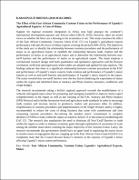| dc.contributor.author | Kabasinguzi, Brenda | |
| dc.date.accessioned | 2018-11-17T09:20:02Z | |
| dc.date.available | 2018-11-17T09:20:02Z | |
| dc.date.issued | 2010 | |
| dc.identifier.citation | Kabasinguzi, B. (2010). The Effect of the East African Community Customs Union on the Performance of Uganda’s Agricultural Exports: A Case of Maize. Uganda Martyrs University, Nkozi: Uganda Martyrs University. | en_US |
| dc.identifier.uri | http://hdl.handle.net/20.500.12280/1088 | |
| dc.description.abstract | KABASINGUZI BRENDA (2010-M162-20003)
The Effect of the East African Community Customs Union on the Performance of Uganda’s Agricultural Exports: A Case of Maize.
Support for regional economic integration in Africa runs high amongst the continent‟s international development partners and African elites (OECD, 2010). However, there are mixed views on whether the blocs are a blessing to the economies or not. This study examines the effect of the East African Community Customs Union (EAC CU) on Uganda‟s agricultural exports performance with specific focus on Maize exports covering the period (2009-2012). The objectives of the study are: to identify the relationship between customs procedures and the performance of maize as an agricultural export, to establish the relationship between trade creation and the performance of maize as an agricultural export and to determine the relationship between non-tariff barriers and the performance of maize as an agricultural export. The study employs a correlational research design with both quantitative and qualitative approaches and the Pearson correlation coefficient and regressions where tables are adopted and applied for data analysis. The findings indicate that there is a significant relationship between customs procedures in the EAC and performance of Uganda‟s maize exports; trade creation and performance of Uganda‟s maize exports as well as non-tariff barriers and performance of Uganda‟s maize exports to the region. The study revealed that non-tariff barriers were the key factors hindering the exportation of maize within the region and identified them as Sanitary and Phyto-Sanitary measures, roadblocks and weigh bridges.
The research recommends taking a holistic regional approach towards the establishment of a coherent and agreed-upon vision for promoting and managing standards to improve maize export competitiveness in the region as well as fast tracking of the EAC Sanitary and Phyto-Sanitary (SPS) Protocol and to further harmonise food and agriculture trade standards in order to encourage trade creation and increase returns to producers, traders and processors alike. In addition, simplification of customs procedures and implementation of the Single Window policy is highly recommended to reduce the costs of doing business that come with cumbersome and time consuming customs procedures. Re-echoing the member states‟ commitment to complete abolition of NTBs to trade within the region as stated in Article 13 of the protocol establishing the EAC CU. The research also emphasises the need to eliminate all Non-Tariff Barriers to trade within the region in order to enhance economic gains through exploitation of economies of scale among the member states hence realising the major objectives of the Customs Union. Lastly, the research recommends that government should have an upper hand in regulating the maize sector to resolve issues of segregation that are cropping up in the East African Grain Council (EAGC) as complaints state that the Council favours Kenya‟s interests at the expense of Uganda‟s hence affecting Uganda‟s maize export performance.
Key Words: East African Community, Customs Union, Uganda’s Agricultural Exports, Maize. | en_US |
| dc.language.iso | en | en_US |
| dc.publisher | Uganda Martyrs University | en_US |
| dc.subject | East African Community C | en_US |
| dc.subject | Customs Union | en_US |
| dc.subject | Uganda’s Agricultural Exports | en_US |
| dc.subject | Maize | en_US |
| dc.title | The Effect of the East African Community Customs Union on the Performance of Uganda’s Agricultural Exports: A Case of Maize. | en_US |
| dc.type | Thesis | en_US |


